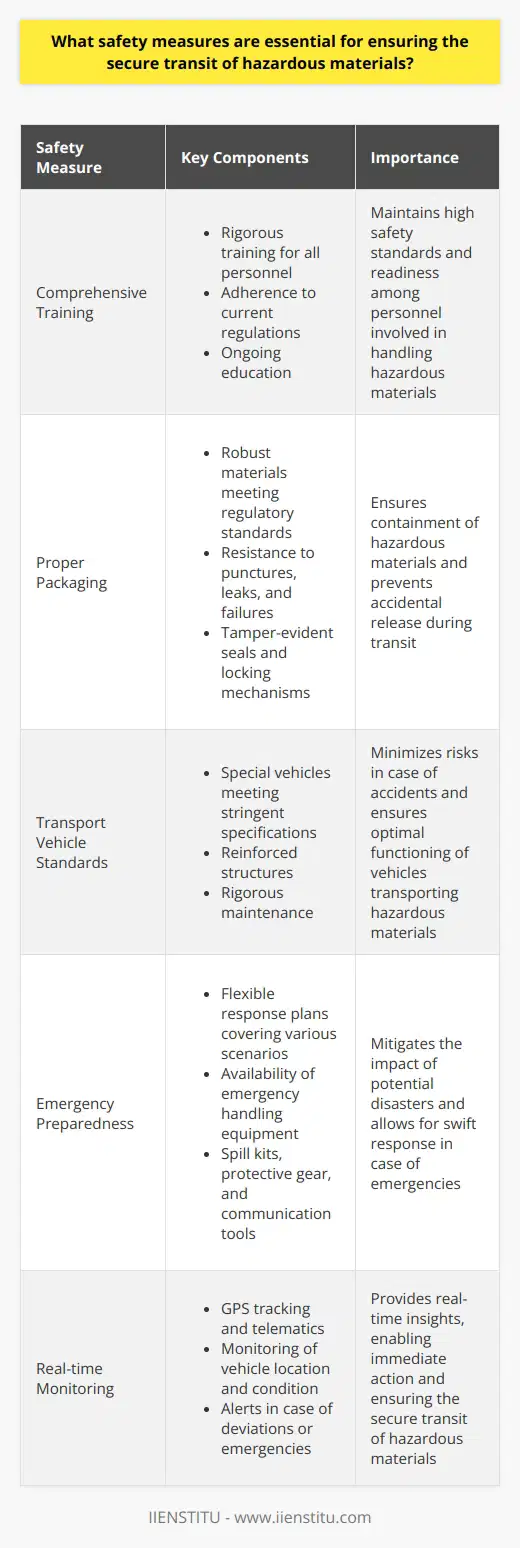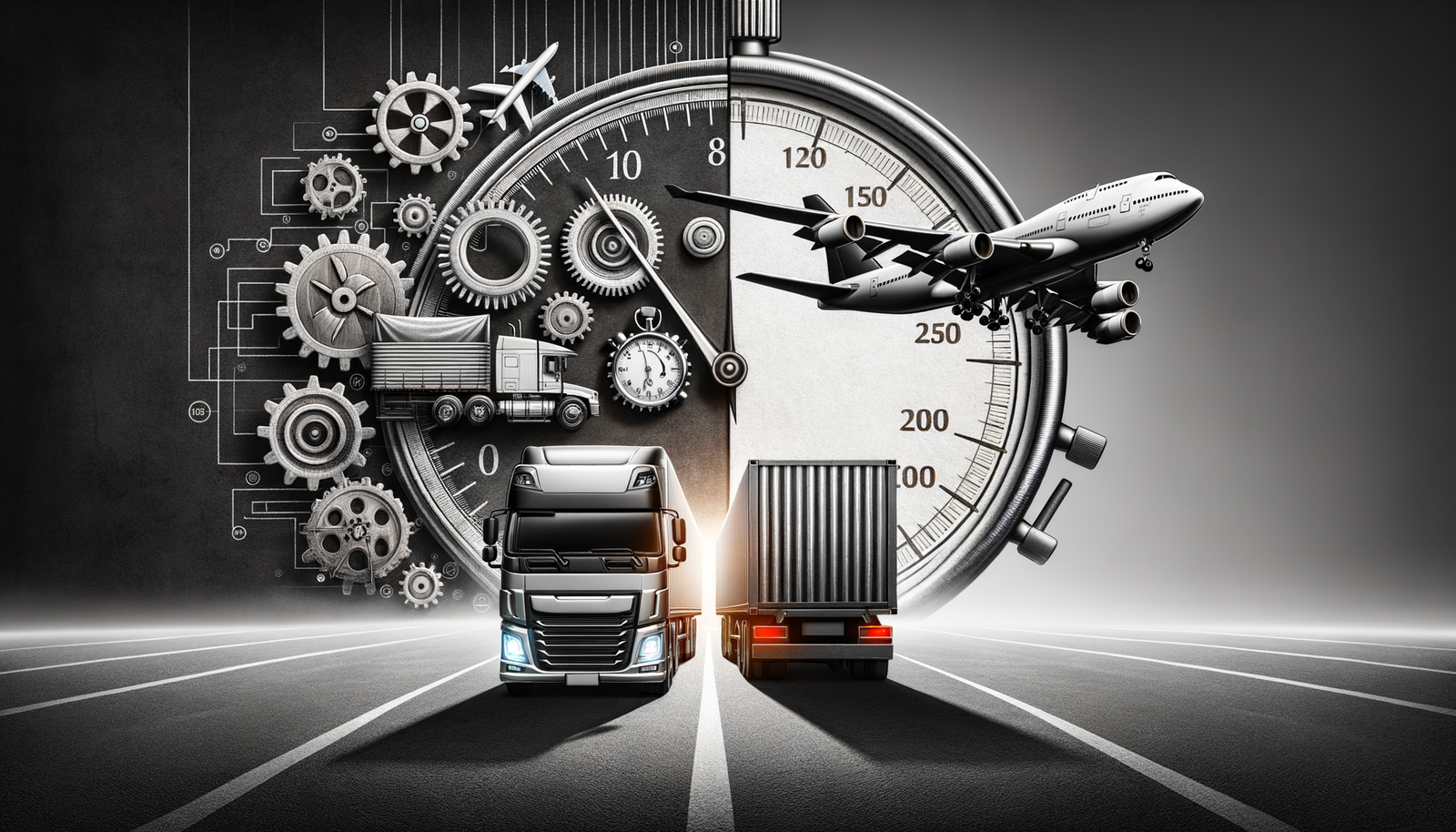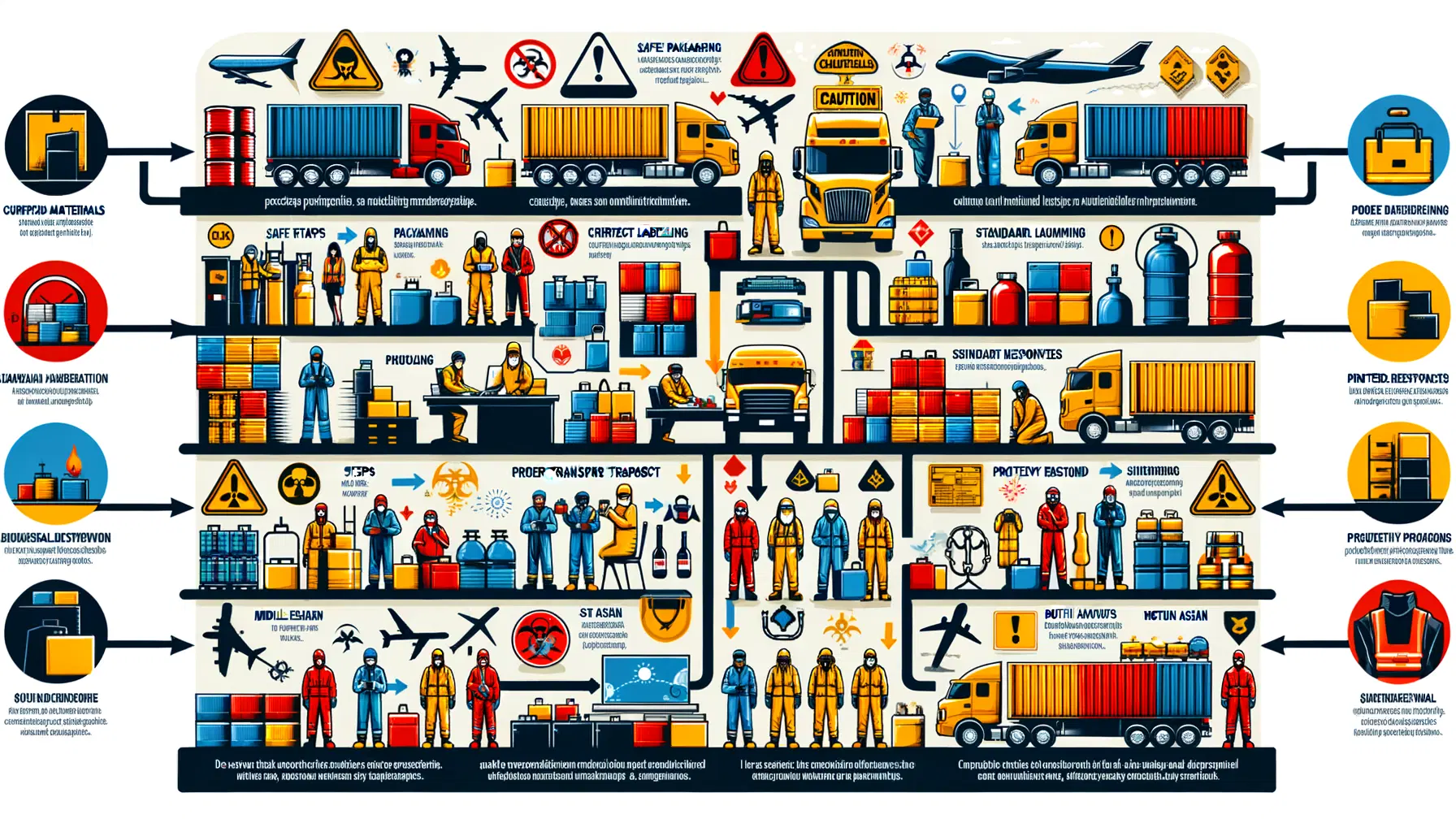
The Intricacies of Hazardous Materials Shipping: A Closer Look
Shipping hazardous materials is a complex process that involves numerous safety protocols and regulations. From corrosive chemicals to explosive compounds, the movement of these dangerous goods poses risks that require meticulous management. A thorough understanding of hazardous materials shipping is vital, not only for the safety of those handling the materials but also for the protection of the environment and the general public.
I remember my first encounter with hazardous materials shipping when I worked at a chemical manufacturing plant. The plant manager emphasized the importance of following the *hazardous materials shipping regulations to the letter. He shared a story about a former employee who had failed to properly label a shipment of sulfuric acid, resulting in a leak that caused significant damage to the transport vehicle and put the driver at risk. This incident highlighted the critical role that hazmat shipping regulations* play in ensuring the safety of everyone involved in the process.
This article aims to dissect the details and regulatory framework of this critical subject, providing insights into the *best practices for hazardous materials shipping*, ensuring efficiency and safety.
Understanding Hazardous Materials
Definition and Examples of Hazardous Materials
Hazardous materials, often referred to as hazmat, encompass a broad range of substances that pose significant risks to health, safety, and property during transportation. Examples include but are not limited to:
Flammable liquids like gasoline
Toxic chemicals like pesticides
Corrosive substances such as strong acids and bases
Radioactive materials
The diversity of hazardous materials necessitates a robust and specific classification system, therefore categorizing these materials is essential to ensure they are handled appropriately.
Hazards Associated with Certain Materials
The hazards associated with hazardous materials can be immediate, such as an explosion or toxic release, or they can have long-term environmental impacts. For instance, a leak of oil may cause not only immediate fire hazards but also long-lasting ecological damage. The properties of each material--volatility, reactivity, toxicity, and corrosiveness--determine its potential for harm and set the parameters for the precautions needed during transport.
How To Optimize Logistics Management For Faster Order Processing Time
Long Tail Keyword For Maximizing Value Through Logistics Management
I once witnessed the aftermath of a hazardous material spill on a highway. A tanker truck had overturned, spilling gallons of a toxic chemical onto the road. The acrid smell and the sight of emergency responders in full protective gear was a stark reminder of the dangers these materials pose when not handled correctly. It took hours for the cleanup crew to contain the spill and decontaminate the area, demonstrating the extensive resources required to manage such incidents.
The Role of Hazardous Materials Regulations in Ensuring Safety
To manage the risks associated with transporting hazardous materials, a set of regulations known as the Hazardous Materials Regulations (HMR) has been established. These *roles of hazmat shipping regulations* govern the classification, packaging, handling, and transport of hazardous materials. By setting forth comprehensive guidelines, the HMR aims to prevent accidents and ensure the safety of transporters, the public, and the environment. Adherence to these regulations is not merely a suggestion--it is a mandatory practice for all parties involved.
Regulations Governing Hazardous Materials Shipping
Overview of Hazardous Material Regulations (HMR)
HMR encompasses a broad set of rules formulated by the Pipeline and Hazardous Materials Safety Administration (PHMSA). They include guidelines on the documentation, labeling, and packaging required for transporting hazardous materials. Through HMR, the specific responsibilities of manufacturers, shippers, and carriers are defined to promote a uniform process that minimizes risks during transportation.
In my experience working with a logistics company specializing in hazardous materials, I learned the importance of staying updated with the latest HMR. The regulations are continually evolving to address new hazards and incorporate technological advancements. Regular training sessions and a culture of safety were integral to our operations, ensuring that every employee understood their role in maintaining compliance.
Explanation of How HMR Ensures Safe Transportation
The HMR ensures the safe transportation of hazardous materials by requiring precise classification of the materials, followed by strict packaging standards designed to withstand the rigors of movement and potential accidents. The regulations also mandate training for individuals involved in the shipment process and establish protocols for reporting and handling emergencies. Through these measures, the PHMSA aims to create a safety culture around hazardous materials shipping.
One critical aspect of HMR is the requirement for proper labeling and placarding of hazardous materials shipments. These labels and placards serve as visual cues, instantly communicating the nature of the hazard to anyone who encounters the shipment. I recall an incident where a mislabeled package of lithium batteries caused a fire in a cargo hold, underscoring the importance of accurate labeling in preventing accidents.
International Regulations and Their Impact on Hazardous Materials Shipping
In addition to national regulations, international standards such as the International Maritime Dangerous Goods Code and the Technical Instructions for the Safe Transport of Dangerous Goods by Air create globally accepted practices for hazardous materials shipping. These frameworks ensure safety across borders and facilitate international trade while reducing the risks linked to the transfer of hazardous materials between countries and regions.
I had the opportunity to work on a project involving the international shipment of a hazardous chemical. Navigating the complexities of multiple regulatory frameworks was a challenge, but it also highlighted the importance of international cooperation in ensuring the safe movement of dangerous goods. By adhering to these global standards, we were able to successfully transport the chemical without incident, demonstrating the effectiveness of a harmonized approach to hazardous materials shipping.
Steps in Shipping Hazardous Materials Safely
Identification and Classification of Hazardous Materials
Proper identification is the first step to ensure the safety of shipping hazardous materials. This involves determining the chemical and physical properties of the material, which would then be categorized into one of nine UN hazard classes. Precise classification dictates the regulations that will apply to its packaging, handling, and transportation.
I remember a case where a shipment of paint was misclassified as a non-hazardous material. During transport, the containers leaked, causing a fire in the warehouse. The incident underscored the critical importance of accurate classification in preventing accidents and ensuring the appropriate handling of hazardous materials.
Proper Packaging and Labeling in Accordance with Regulations
Following classification, materials must be packaged in compliance with HMR standards. Packages must withstand changes in temperature, pressure, and movement to prevent leakage or other forms of compromise. The labeling of these packages with proper hazard warnings and handling instructions is equally critical, as it provides those along the supply chain with vital information on how to manage and respond to the contents safely.
In my role as a hazardous materials packaging specialist, I was responsible for ensuring that every package met the stringent requirements set forth by the HMR. This involved selecting the appropriate packaging materials, conducting rigorous testing, and verifying that all labels and markings were accurate and clearly visible. Attention to detail was paramount, as even a small oversight could have serious consequences down the line.
Completion of Required Shipping Papers
The transport of hazardous materials is accompanied by a comprehensive set of shipping papers that serve as a record of the materials being shipped, their hazard classification, and the handling instructions necessary for their safe transit. Providing accurate and detailed shipping papers is not merely a formality--its a vital safety measure and a legal requirement.
I once witnessed the consequences of incomplete shipping papers firsthand. A shipment of flammable liquids arrived at a distribution center without the proper paperwork, causing confusion and delays in handling. The lack of clear information about the nature of the hazard put the workers at risk and highlighted the critical role that shipping papers play in ensuring the safe and efficient movement of hazardous materials.
Necessity of Emergency Response Information
In the occurrence of an incident, readily available emergency response information can be the difference between a controlled situation and a disaster. This information includes the material safety data sheets and emergency contact numbers, which should be easily accessible to first responders and personnel to ensure an immediate and appropriate response.
*Emergency response in hazardous materials transport* is a critical component of the overall safety framework. I had the opportunity to participate in an emergency response drill simulating a hazardous material spill. The experience emphasized the importance of having clear, readily available information to guide the response efforts. From the proper protective equipment to the specific containment and cleanup procedures, every aspect of the response relied on accurate and up-to-date emergency response information.
Training Required for Individuals Involved in Hazardous Materials Shipping
Personnel who handle hazardous materials must undergo specialized training for hazmat shipping personnel, as mandated by the HMR. This training covers the correct handling procedures, understanding of documentation, emergency response actions, and awareness of legal responsibilities. Continual education and refresher courses are also necessary to stay updated on regulations and best practices.
Throughout my career in hazardous materials shipping, I have participated in numerous training programs. These sessions not only provided me with the technical knowledge needed to perform my job safely but also instilled a deep sense of responsibility and commitment to following best practices. The training emphasized the potential consequences of non-compliance, from environmental damage to loss of life, underscoring the critical importance of adhering to the regulations and maintaining a culture of safety.
Risks Associated with Non-compliance in Hazardous Materials Shipping
Legal Penalties for Non-compliance
Companies and individuals found in violation of the HMR can face severe legal *penalties for non-compliance in hazmat shipping*, including fines and, in extreme cases, imprisonment. The costs associated with non-compliance reinforce the need for thorough understanding and strict adherence to regulations to avoid legal repercussions.
I once witnessed the legal fallout of a company that routinely cut corners in their hazardous materials shipping practices. When an inspection revealed multiple violations of the HMR, the company faced hefty fines and legal action. The financial and reputational damage was significant, serving as a sobering reminder of the importance of compliance.
Safety Risks Due to Non-compliance
Ignorance or willful disregard for HMR can put the lives of transporters, handlers, and the public at risk. Non-compliance may unpredictably transform a regular shipment into a ticking bomb--if even a small detail is overlooked, the consequences can be catastrophic, ranging from chemical burns to large-scale explosions.
I vividly remember a case where a company failed to properly secure a shipment of compressed gas cylinders. During transport, the cylinders shifted and ruptured, releasing a toxic gas cloud that endangered the lives of the driver and nearby residents. The incident served as a stark reminder of the very real safety risks associated with non-compliance in hazardous materials shipping.
Impact on the Environment
The environmentally deleterious effects of non-compliance cannot be understated. Spills, leaks, and explosions can result in the long-term degradation of ecosystems, contamination of water sources, and harm to wildlife. The aftermath of such incidents typically requires extensive cleanup efforts and can incur significant ecological restoration costs.
In one particularly devastating case, a company's failure to properly maintain its storage tanks led to a massive leak of hazardous chemicals into a nearby river. The environmental impact was catastrophic, with thousands of fish killed and the surrounding ecosystem severely damaged. The cleanup effort took years and cost millions of dollars, underscoring the long-term consequences of non-compliance.
Case Studies: Incidents in Hazardous Materials Shipping
Discussion of Past Hazardous Materials Shipping Incidents
There have been multiple notable incidents where non-compliance or mismanagement of hazardous materials shipping resulted in disaster. For instance, the 2013 Lac-Megantic rail disaster in Quebec involved an unattended train carrying crude oil that derailed and exploded, demonstrating the importance of proper handling and safety precautions.
Another incident that comes to mind is the 2010 Deepwater Horizon oil spill in the Gulf of Mexico. While not strictly a shipping incident, it highlighted the devastating consequences of inadequate safety measures and emergency response protocols in the handling of hazardous materials. The spill resulted in the loss of human life, extensive environmental damage, and billions of dollars in cleanup and restoration costs.
Lessons Learned and Changes in Regulations as a Result
Every incident provides an opportunity to learn and adapt. In many cases, accidents have led to the tightening of regulations, improvements in safety practices, and enhanced training for personnel. Analyzing these cases helps industry stakeholders and regulators prevent recurrence by identifying and addressing systemic vulnerabilities.
Following the Lac-Megantic disaster, for example, regulators in the United States and Canada implemented stricter rules for the transportation of crude oil by rail, including more stringent tank car standards, enhanced braking systems, and improved emergency response planning. These changes aimed to prevent similar tragedies from occurring in the future.
Modern Technologies and Hazardous Materials Shipping
Role of Technology in Improving Hazardous Materials Shipping Safety
The integration of *modern technology in hazardous materials shipping* has substantially transformed the safety landscape of hazardous materials shipping. Innovations like real-time tracking, sensors, and advanced containment systems increase transparency and proactive management, minimizing risks by alerting to potential issues before they escalate into emergencies.
In my experience, the adoption of technology has revolutionized the way we approach hazardous materials shipping. From GPS tracking that allows us to monitor shipments in real-time to smart packaging that can detect and report leaks, these advancements have greatly enhanced our ability to ensure the safe and secure transport of dangerous goods.
Explanation of Specific Technologies like GPS, IoT, AI
Technologies such as Global Positioning System (GPS), Internet of Things (IoT), and Artificial Intelligence (AI) are being deployed to enhance safety measures. GPS enables precise location monitoring; IoT connects various sensors across transportation vehicles and containers to pass real-time data; AI algorithms can predict potential risks based on vast data sets and historical patterns. Collectively, these technologies create a more controlled and responsive hazardous materials shipping environment.
I had the opportunity to work on a project implementing an IoT-based monitoring system for hazardous materials shipments. The system utilized a network of sensors to track temperature, pressure, and other critical parameters, sending real-time alerts if any anomalies were detected. This allowed us to proactively address potential issues and prevent accidents before they occurred, demonstrating the transformative potential of these technologies.
Conclusion
Delving into the intricacies of hazardous materials shipping highlights the critical importance of understanding and strict compliance with regulations. The commitment to safety must be unwavering, as the impacts of mishandling these materials can be devastating. As we look to the horizon, technology stands as a beacon of progress, offering new ways to mitigate risks and safeguard the future of hazardous materials shipping. It is the collective responsibility of all stakeholders to engage with these regulations and innovations, preserving both human life and the environment.
My journey in the world of hazardous materials shipping has been one of continuous learning and growth. From my early days as a novice, grappling with the complexities of the regulations, to my current role as a seasoned professional, I have witnessed firsthand the evolution of this critical industry. The lessons I have learned, the incidents I have studied, and the advancements I have seen have all reinforced the paramount importance of vigilance, knowledge, and a steadfast commitment to safety.
As we move forward, it is essential that we continue to embrace innovation while remaining grounded in the fundamental principles of hazardous materials shipping safety. By combining the power of technology with the wisdom of experience, we can create a future where the movement of dangerous goods is safer, more efficient, and more sustainable than ever before. It is a future that demands our unwavering dedication, our constant vigilance, and our collective expertise. And it is a future that we must all work together to build, one shipment at a time.
References
1- Strachan, R. (2019). Hazardous Materials Compliance Pocketbook. J. J. Keller & Associates, Inc.
2- Kole, P. J., & Abkowitz, M. D. (2017). Hazardous Materials Transportation Safety: A Guide to Risk Assessment and Regulatory Compliance. John Wiley & Sons, Inc.
3- Haddow, G. D., Bullock, J. A., & Coppola, D. P. (2014). Introduction to Emergency Management (5th ed.). Elsevier Inc.
4- Liu, X., Saat, M. R., & Barkan, C. P. L. (2016). Hazardous Materials Transportation Risk Assessment: State of the Practice. Transportation Research Board.
5- Tanaka, N. (2018). Safety and Security of Hazardous Materials Transportation: An Analysis of Risk and Mitigation Strategies. Springer International Publishing.
6- Mercurio, P. J. (2019). Hazardous Waste Management Compliance Handbook (2nd ed.). Bernan Press.
Frequently Asked Questions
What are the primary considerations in arranging the transportation of hazardous materials?
Understanding Hazardous Materials Transportation
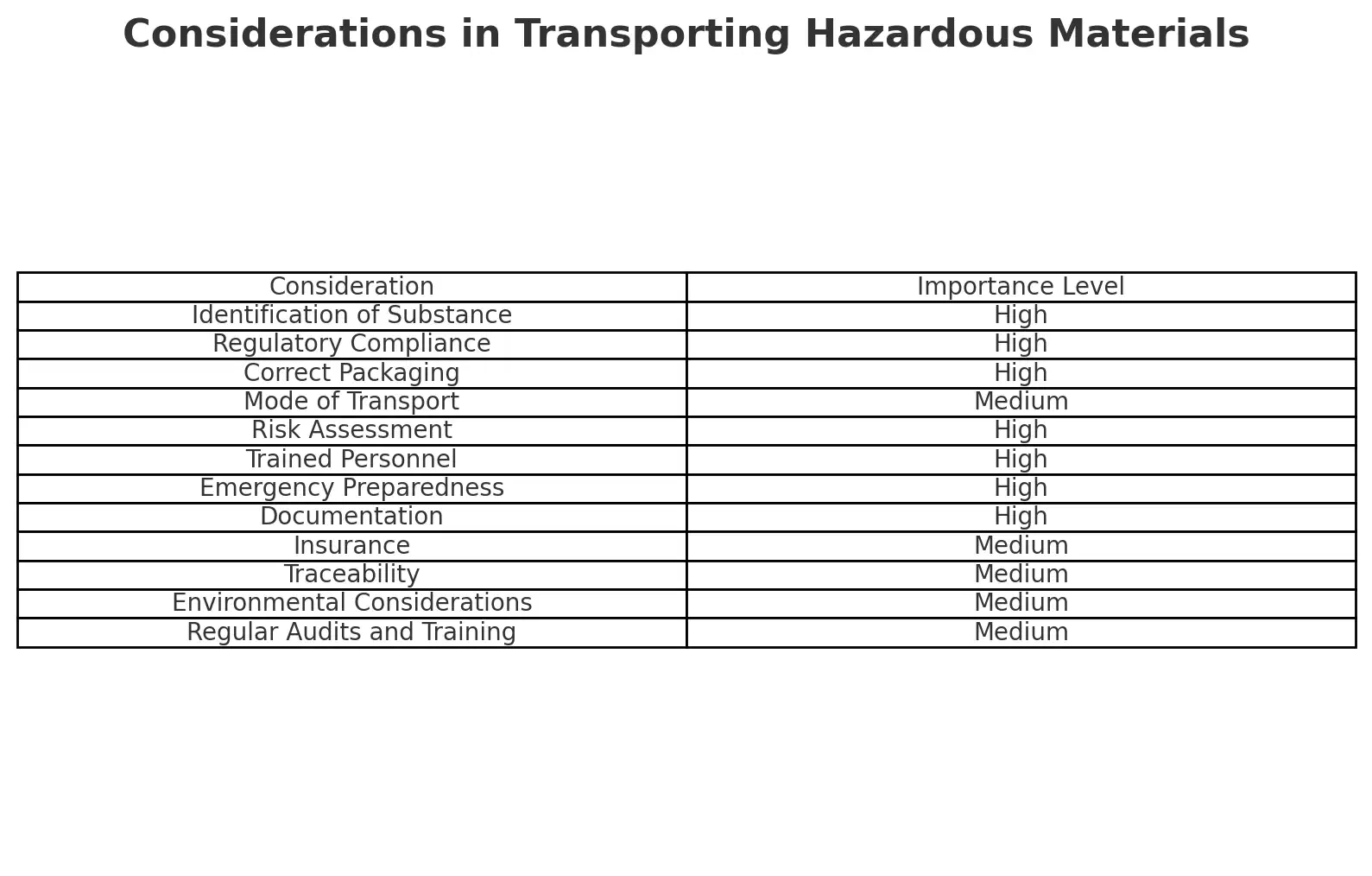
When arranging the transportation of hazardous materials, several factors demand attention. These concern safety, legality, and efficiency. Understanding these will guide the transport process.
Identify the Substance
First, identify the material. Hazardous goods vary in nature. They could be flammable, explosive, toxic, or corrosive. Accurate classification is crucial. It informs risk assessments and safety procedures.
Regulatory Compliance
Next, consider regulations. Transportation of hazardous materials falls under strict legal control. This ensures public safety and environmental protection. National and international guidelines apply. Shippers must comply with all relevant laws.
Choose the Correct Packaging
Packaging is essential. It must be robust and appropriate. Containers should withstand accidents. They must prevent leaks and spills. Labels are also important. They provide handling instructions and warnings.
Select the Proper Mode of Transport
Transport mode selection comes next. Options include road, rail, air, and sea. Each has its own pros and cons. Risks and costs differ. Choose the mode aligning with substance nature, destination, and legal framework.
Risk Assessment
Carry out a risk assessment. This procedure identifies potential hazards. It evaluates the likelihood of occurrence. Strategies stem from this to mitigate risks. Safety is the top priority.
Trained Personnel
Employ trained personnel. Handlers need expertise in managing hazardous materials. Their knowledge and skills are vital. They ensure adherence to safety standards.
Emergency Preparedness
Design an emergency response plan. Accidents can happen despite precautions. A plan outlines steps for dealing with emergencies. It also includes contact information for relevant agencies.
Documentation
Documentation is non-negotiable. Transport documents need completeness and accuracy. They must accompany the shipment. They serve as a guide for handlers and authorities.
Insurance
Secure insurance. Insurance provides financial protection. It covers damages and liabilities. It is a safeguard for the transporter and the client.
Traceability
Maintain traceability. Tracking systems monitor the shipment's journey. They offer real-time updates. These are useful for all parties involved.
Environmental Considerations
Account for environmental impact. Choose eco-friendly options when possible. Consider spill response strategies. They lessen environmental damage in an accident.
Regular Audits and Training
Finally, conduct audits and training. Regular checks ensure compliance. Training updates skills and knowledge. Both are pillars for the ongoing safety of hazardous materials transport.
To sum up, transporting hazardous materials entails careful planning and strict adherence to safety protocols. Grasping the full scope of requirements and the complexities involved leads to responsible and efficacious transport processes.
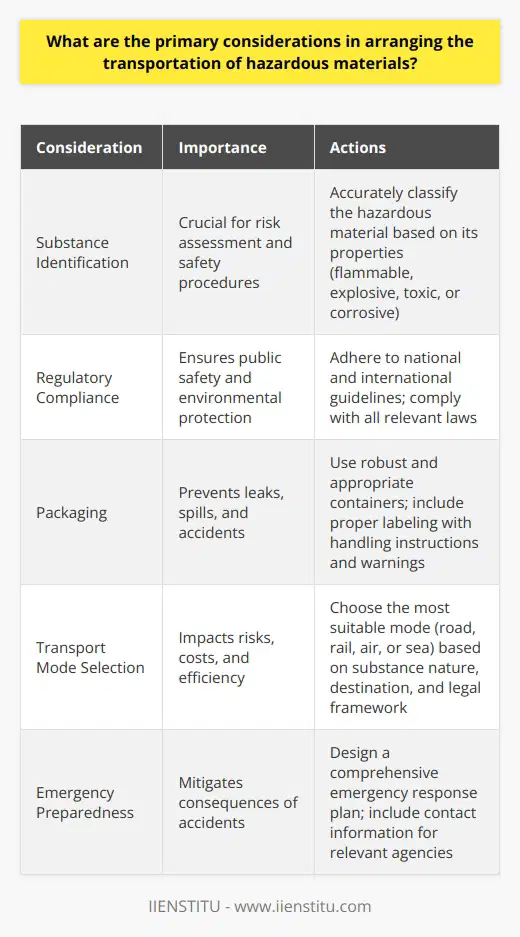
How do national and international regulations affect the shipping protocol for hazardous materials?
National Regulations
National regulations set the domestic ground rules. They dictate how one must handle, package, and transport hazardous materials within a country. In the United States, the Department of Transportation (DOT) oversees these regulations. It mandates strict adherence to safety procedures. The regulations cover classification, packaging, and labeling. They also include training for handlers and emergency response information.
Every shipment requires proper documentation. This includes a declaration of dangerous goods. Failure to comply can lead to legal consequences. Penalties might range from fines to criminal charges. These national rules align with broader international standards.
International Regulations
Shipping beyond borders introduces more complexities. Different countries have their own sets of rules. There is, however, a push for universal guidelines. The International Air Transport Association (IATA) regulates air transport. It draws from the International Civil Aviation Organization (ICAO) technical instructions. For sea shipments, the International Maritime Organization (IMO) provides the International Maritime Dangerous Goods (IMDG) Code.
These organizations work for global safety. They update their codes regularly. They ensure that dangerous goods do not pose risks during transit. All members must adhere to these standards. They apply to labeling, packing, and stowage of hazardous materials. Training for international shipment is also critical. It often includes specific modules on these regulations.
Impact on Shipping Protocols
Compliance necessitates intensive knowledge. Shippers must understand local and global regulations. They must also keep abreast of updates. Changes can occur frequently. Technology advancements also influence protocols. Shippers implement new methods for safer transport.
Planning is key to avoid delays. Shippers must identify the correct classification early. This affects all subsequent documentation and handling steps. Packaging must meet or exceed regulatory requirements. It often involves using certified containers.
Labeling and placarding are equally vital. They provide visual signals to handlers and responders. They also instruct on the nature of the danger. Accurate labeling is non-negotiable. Mislabeling can lead to accidents or legal ramifications.
Documentation ties all steps together. It includes shipping papers, emergency response information, and certificates. This paperwork must be present and correct at all times. It accompanies the shipment throughout its journey.
Conclusion
In sum, national and international regulations are crucial. They define the how-to for hazardous materials shipping. They aim to protect people, property, and the environment. Shipping hazardous materials requires diligence and expertise. Shippers bear the responsibility to ensure safety. They must align their protocols with these regulations. As trade globalizes further, international compliance will only grow in importance.
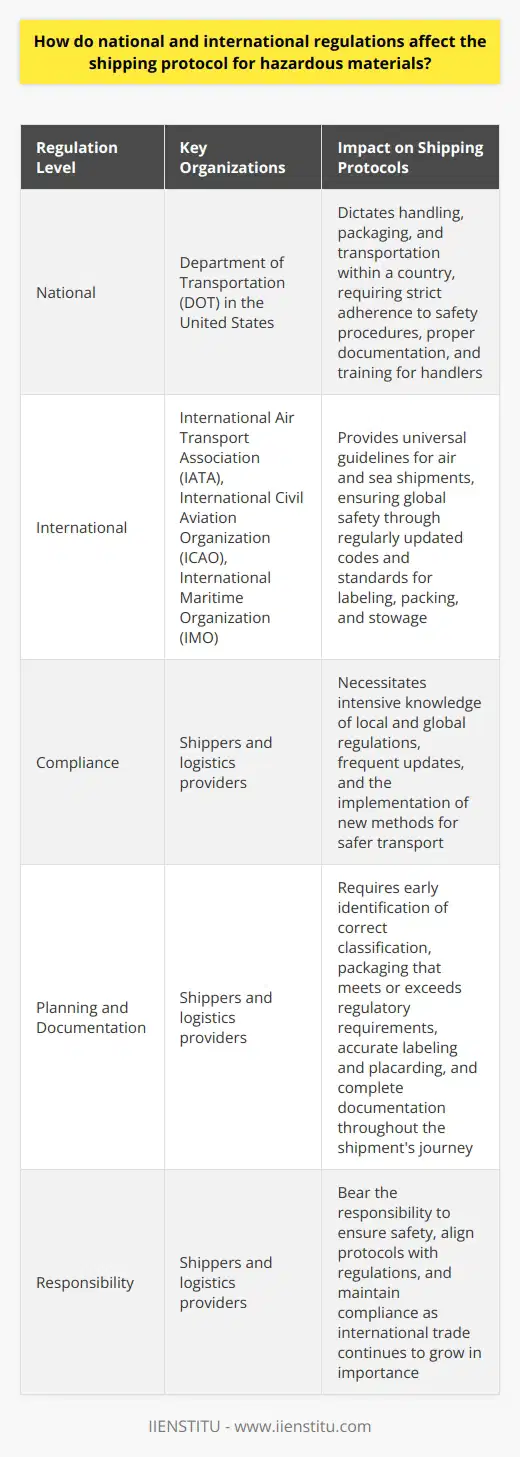
What safety measures are essential for ensuring the secure transit of hazardous materials?
Essential Safety Measures for Hazardous Materials Transit
Comprehensive Training
Training remains paramount. All personnel must undergo rigorous training. This includes drivers, handlers, and emergency responders. Training programs must adhere to current regulations. They frequently cover material handling, emergency procedures, and first aid. Ongoing education is also critical. It maintains high safety standards and readiness.
Proper Packaging
Packaging demands robust materials. These must meet or exceed regulatory standards. Containers should resist punctures, leaks, and failures. They often feature tamper-evident seals and locking mechanisms. Packaging should also withstand environmental challenges. These include temperature extremes and pressures.
Accurate Labeling
Labels convey essential information. They must display hazard classifications clearly. Each label requires immediate comprehension. It should showcase handling instructions and risk levels. Durable materials are inclement weather-resistant. Label integrity is crucial across all transit stages.
Transport Vehicle Standards
Special vehicles transport hazardous materials. These vehicles must meet stringent specifications. They often have reinforced structures. These minimize risks in case of accidents. Maintenance of these vehicles is rigorous. Regular checks ensure optimal functioning.
Route Planning
Secure transit involves careful route planning. Planners must consider distance, traffic patterns, and potential hazards. Routes should avoid densely populated areas. Planners often choose paths with multiple emergency facilities nearby.
Emergency Preparedness
Preparedness mitigates disasters. It involves having response plans ready. These plans should be flexible and cover various scenarios. Equipment for handling emergencies must be available. This includes spill kits, protective gear, and communication tools.
Regulatory Compliance
Regulations govern hazardous material transit. Compliance is not optional. Authorities such as the DOT or EPA set these rules. They often change and require constant monitoring. Non-compliance can lead to severe penalties.
Real-time Monitoring
Technology plays a key role. GPS tracking and telematics offer real-time insights. They help in monitoring the vehicle's location and condition. Alerts go out in case of deviations or emergencies. This allows for immediate action.
Security Protocols
Theft or sabotage can be catastrophic. Security measures prevent unauthorized access. They include background checks, security personnel, and surveillance. Cargo integrity checks are frequent. Audits prevent procedural lapses.
Communication
Effective communication binds these measures. Clear protocols ensure swift information flow. Drivers and dispatch must stay in constant contact. They should use secure communication channels for confidentiality.
Implementing these safety measures is complex yet essential. Each step in the process ensures the secure transit of hazardous materials. It protects people, property, and the environment. Continuous improvements in standards and practices aim to further reduce risk.
